Brad Nailer vs Finish Nailer (Which to Choose & Why)
Choosing between a brad nailer and a finish nailer can be confusing. I’ll break down the similarities, differences and discuss the best uses for each.
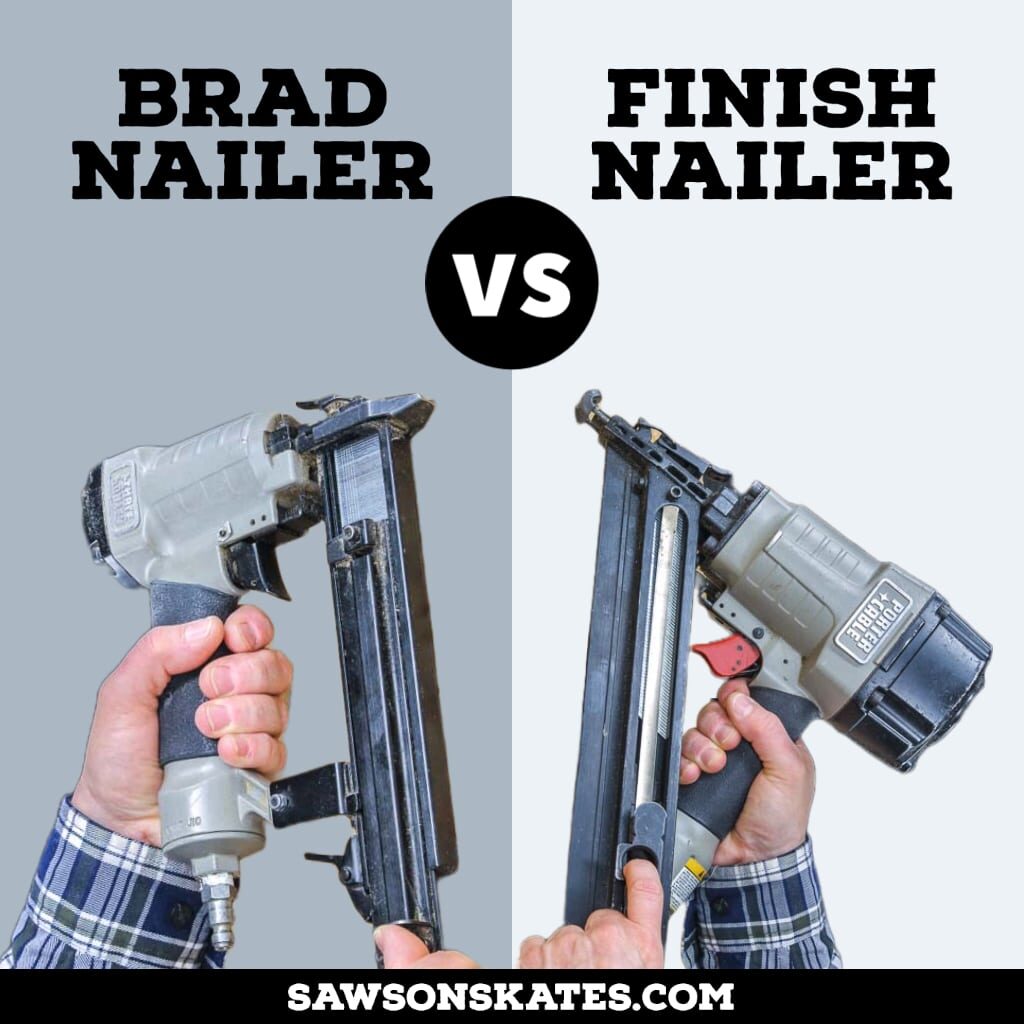
A finish nailer and a brad finish nailer look similar but differ in strength and the size of the nails they use.
Which is better for attaching thin, narrow molding? Which is better for installing baseboards and crown molding? Which one should you buy first? Learn the differences between them and how to choose the right one for your DIY projects in this easy-to-understand comparison.
Originally published August 17, 2021, updated February 4, 2023.
Table of Contents
- What is a Brad Nailer?
- What is a Brad Nailer Used For?
- Brad Nailer Pros and Cons
- What is a Finish Nailer?
- What is a Finish Nailer Used For?
- Finish Nailer Pros and Cons
- What’s the Difference Between a Brad Nailer and a Finish Nailer?
- Brad Nailer vs Finish Nailer Specs & Comparison Chart
- Should I Buy a Brad Nailer or a Finish Nailer?
- Pneumatic vs Cordless
- Frequently Asked Questions
This article contains affiliate links. If you purchase from these links, I may earn a small commission at no additional cost to you. Visit my site policies for more information.
What is a Brad Nailer?
A brad nailer is a tool that drives small nails, called brads, into wood.
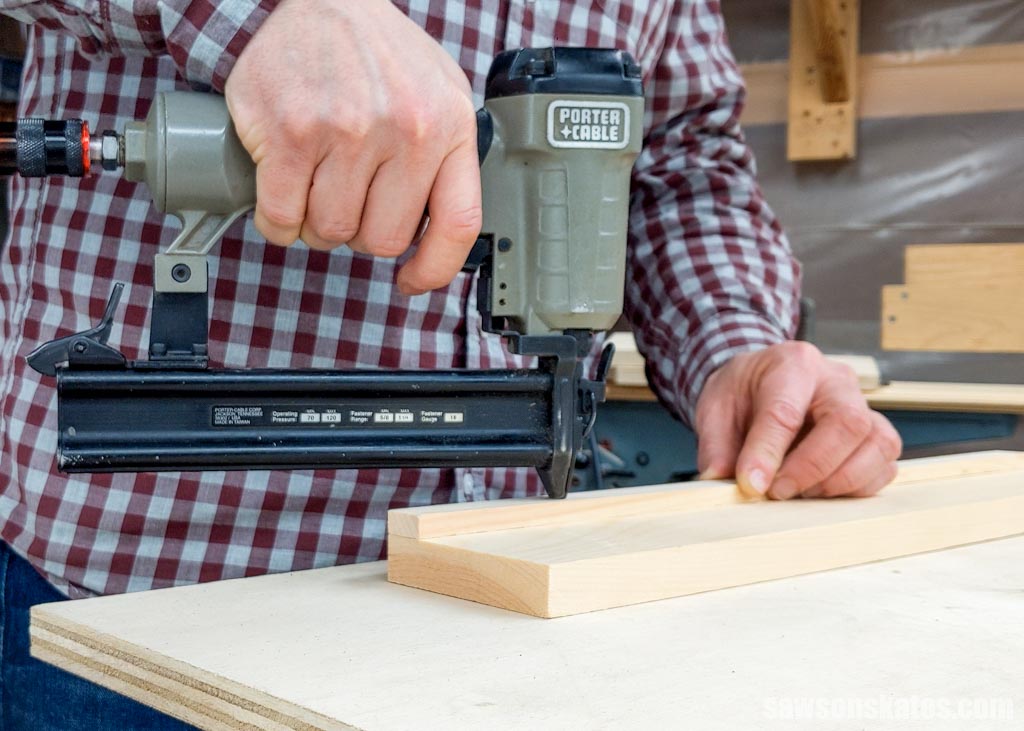
Unlike traditional nails, brads are thin, wire-like fasteners with t-shaped heads. Generally measuring 0.0403 inches in diameter, these 18-gauge nails range between ⅝” to 2-½” inches long, depending on your nailer’s manufacturer. For example, my Porter Cable brad nailer only accepts nails up to 1-¼” long.
The gauge of a nail refers to its thickness. It might seem backwards, but the thinner the nail, the higher the gauge. For example, a 23-gauge pin nail is thinner than an 18-gauge brad nail.
Related: Pin Nailer vs Brad Nailer: Differences & Which to Use
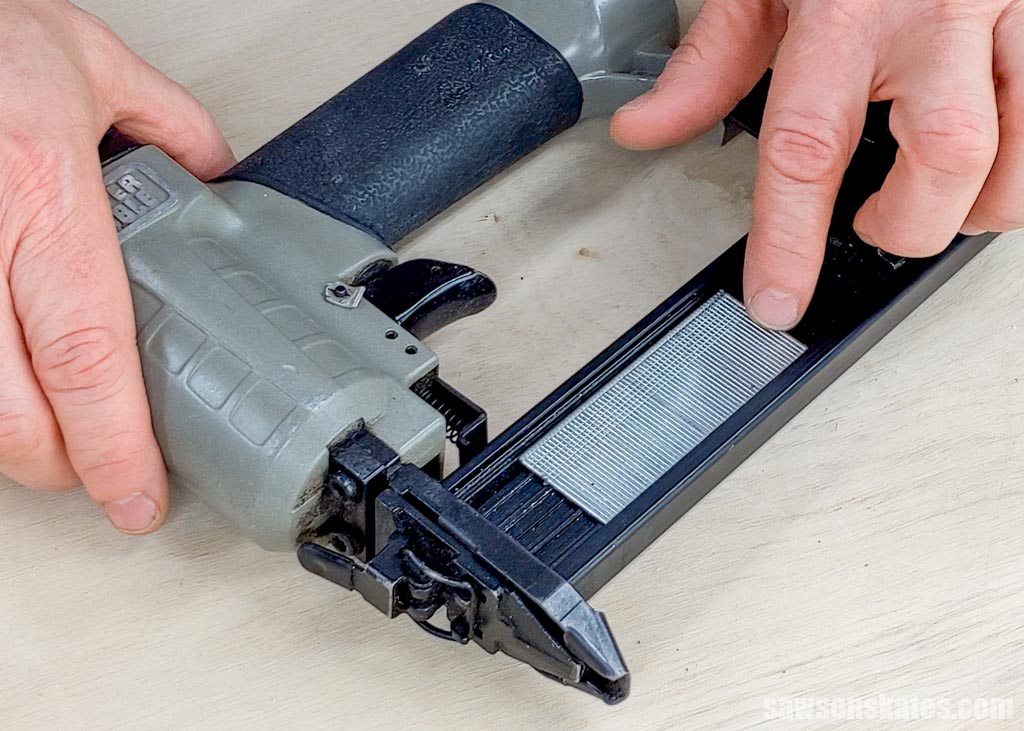
But it makes sense when you think about it this way: gauge measures how many nails fit within an inch. So for 18-gauge nails, you can only fit 18 per inch, but with smaller 23-gauge nails, you can fit 23 per inch.
A nail’s gauge also corresponds to the size of the hole left in the wood, meaning an 18-gauge nail leaves a smaller hole than a 15-gauge nail.
Many do-it-yourselfers feel the small holes left by brad nails are barely noticeable, and you don’t need to hide them with wood filler or putty. However, for certain jobs, especially painted projects, I believe filling these tiny holes gives the project a more polished look.
Related: Wood Putty vs Wood Filler (Which to Use & Why)
What is a Brad Nailer Used For?
Brad nailers are most commonly used for light-duty finish carpentry tasks. Finish carpentry is the last step, where you add the finishing touches to a project.
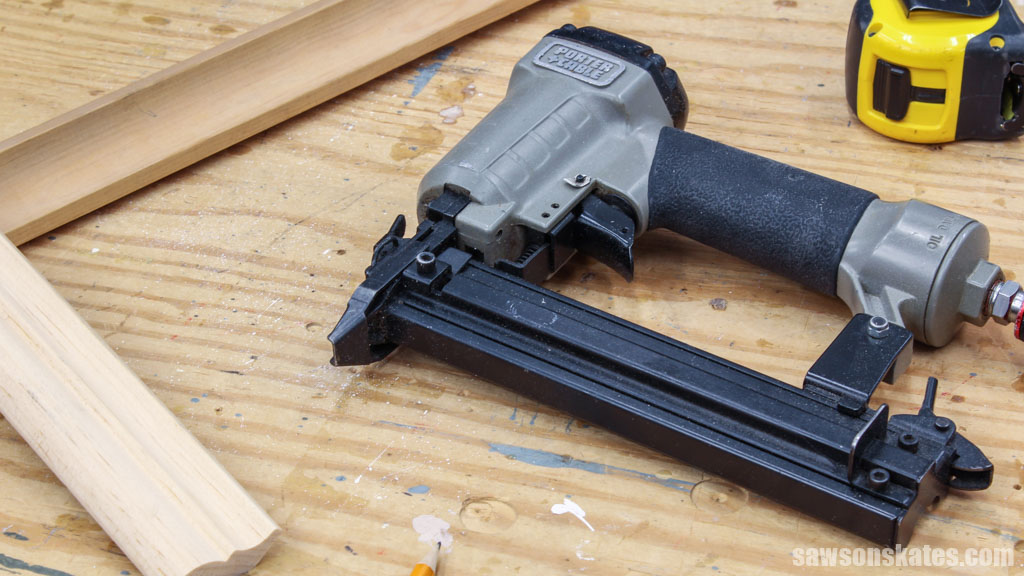
Although brad nailers are often referred to as finish nailers, they are different tools. Finish nailers use larger 15-gauge or 16-gauge nails, whereas brad nailers use smaller 18-gauge nails.
Brad nailers are ideal for projects requiring more finesse, such as attaching narrow trim and small moldings, because their wire-like nails are less likely to crack delicate wood pieces.
You can also use a brad nailer for making small woodworking projects like picture frames, and I’ve used mine to assemble birdhouses, lanterns, phone holders, and more.
While brads are less likely to crack small wood pieces, the drawback is they have less holding power than a larger nail.
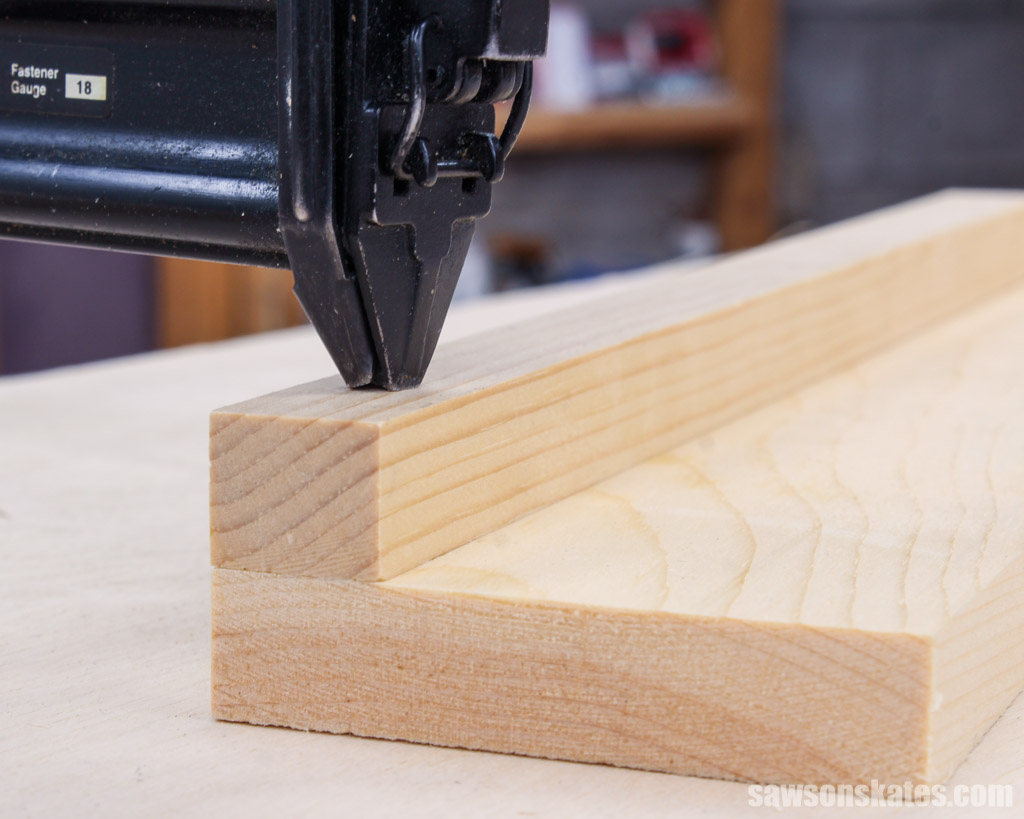
Brad nails don’t have the strength to hold large moldings or large boards in place. Also, they have difficulty going through hardwoods, MDF, and thick pieces of plywood.
Brad nailers are excellent for:
- Attaching lightweight trim on cabinets and DIY furniture projects
- Installing decorative molding
- Installing quarter round, shoe molding, and door stop molding
- Assembling small projects (picture frames, jewelry boxes, birdhouses, etc.)
- Tacking workpieces together while the glue dries
Brad Nailer Pros and Cons
Pros
- Nails leave small holes that require little to no filler
- Less likely to crack delicate wood pieces
- Ideal for narrow trim and small moldings
Cons
- Lacks the holding power to attach large or heavy materials
- Lacks the strength to penetrate hardwoods, MDF, and thick plywood
What is a Finish Nailer?
A finish nailer is a power tool that drives 15-gauge or 16-gauge headless nails into wood. 15 and 16-gauge nails vary in size, ranging from 0.0625 to 0.0800-inches in diameter and 1-inch to 2-½-inches long.
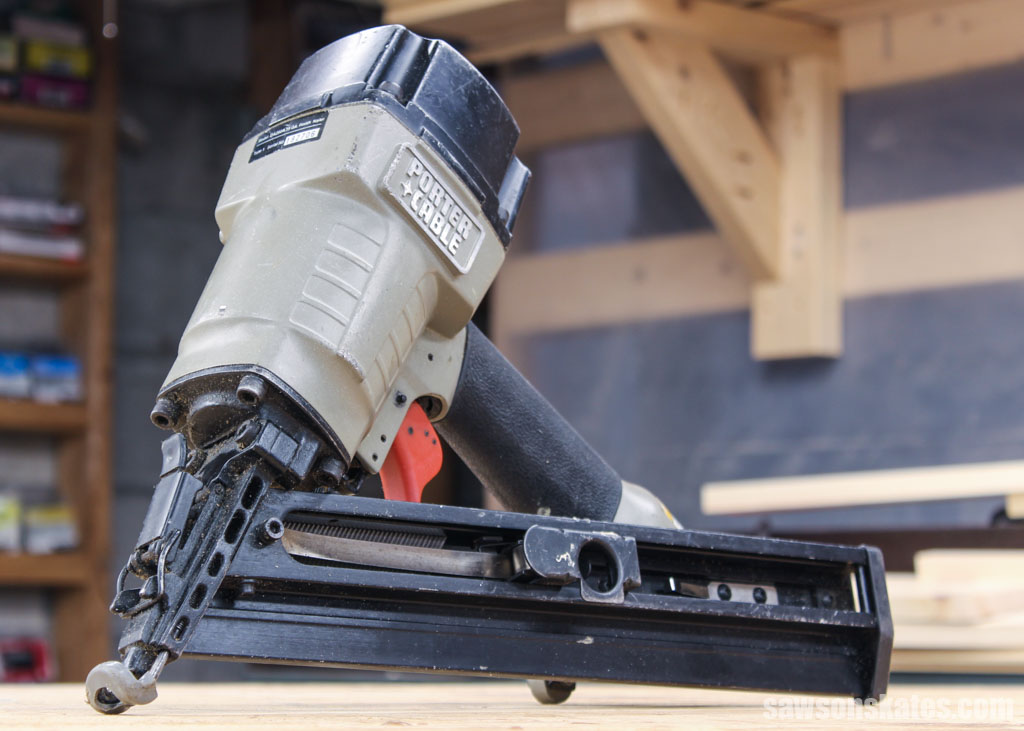
Finish nailers may appear similar in size to framing nailers; however, the latter uses larger 8-gauge or 12-gauge nails.
Related: Finish Nailer vs Framing Nailer (Differences + Which to Use)
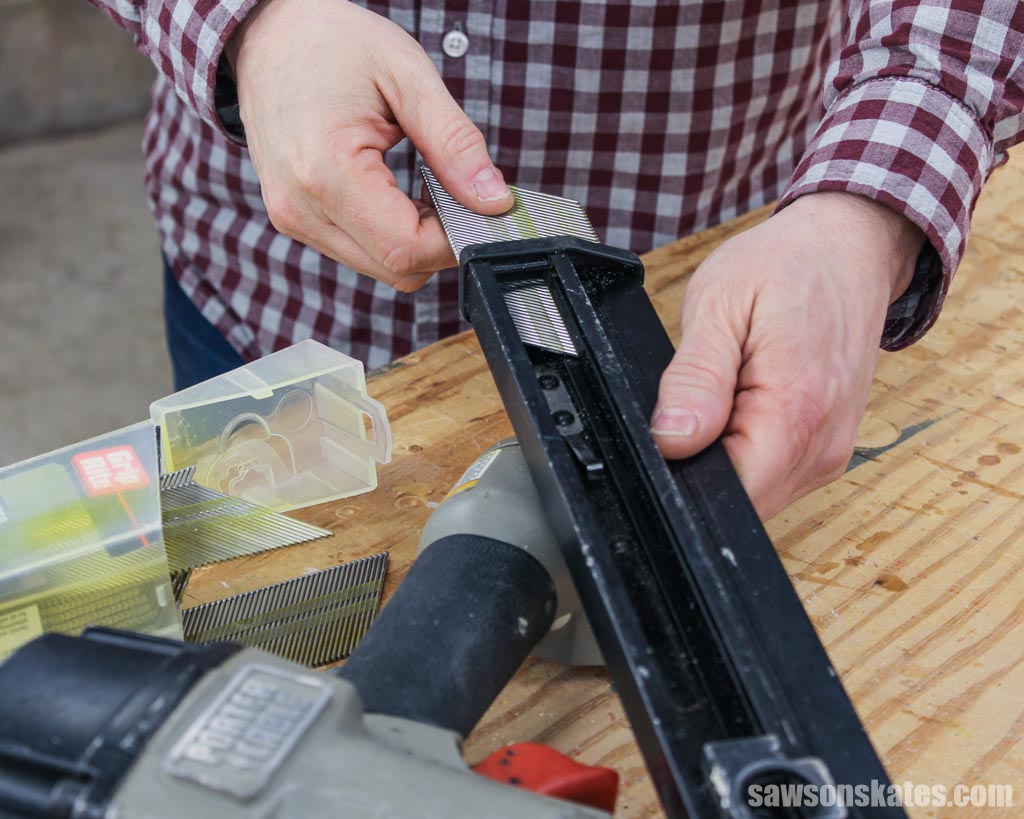
The sizable diameter of finish nails leaves behind large, visible holes, which I recommend hiding with wood filler for a seamless look.
Related: Does Stainable Wood Filler Work? (Here’s the Answer)
💡 TIP: Some finish nails are collated at an angle, and some are straight. Be sure to buy the correct nails for your finish nailer.
What is a Finish Nailer Used For?
Finish nailers are versatile tools ideal for heavier-duty finish carpentry jobs. Their sizable nails have the power to hold large moldings and boards in place, making them perfect for attaching trim pieces like crown molding, baseboards, window casings, and other large moldings.
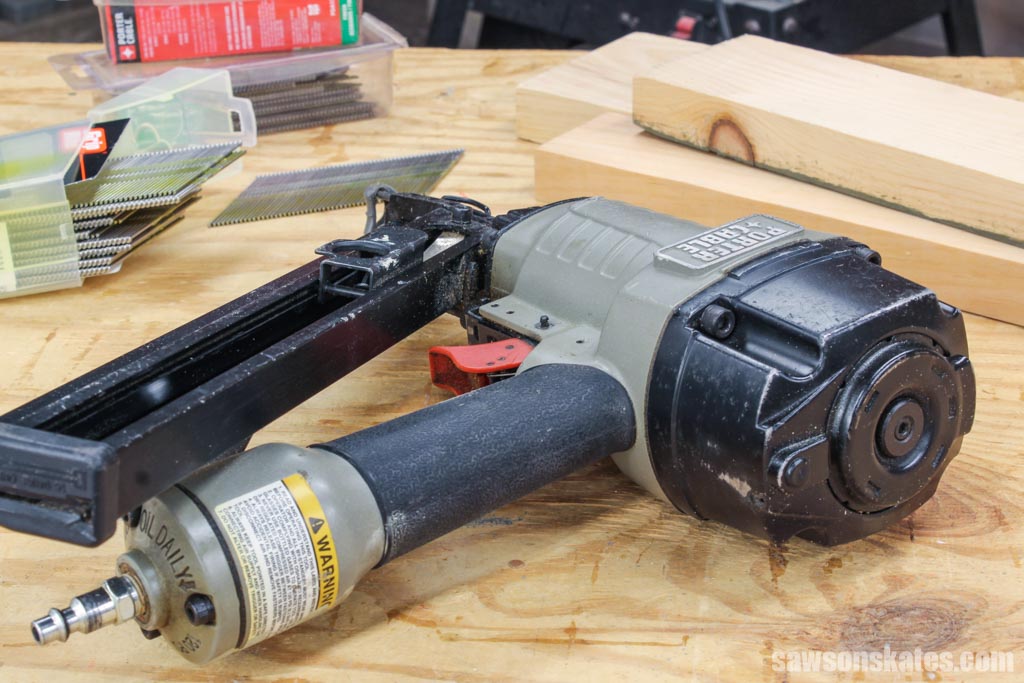
In addition to their impressive holding power, finish nailers have incredible strength that can penetrate materials like hardwoods, MDF, and thick pieces of plywood. However, the drawback is their large nails may crack thin trim pieces and split narrow molding.
Finish nailers are excellent for:
- Baseboards
- Window and Door Trim
- Chair Rails
- Crown Molding
- Heavy or Wide Boards
- Staircases
Finish Nailer Pros and Cons
Pros
- Power to attach large or heavy materials
- Strength to penetrate hardwoods, MDF, and thick plywood
Cons
- Nails leave large holes that require filler
- May crack thin trim pieces and split narrow molding
What’s the Difference Between a Brad Nailer and a Finish Nailer?
Now that we have covered each tool’s basics let’s look at the differences between a finish nailer and a brad nailer.
Nail Size
The primary difference between a brad nailer and a finish nailer is the size of the nail they use. Brad nailers use small, wire-like 18-gauge nails, while finish nailers use larger 15-gauge or 16-gauge nails.
Hole Size
Another difference between finish nailers and brad nailers is the hole size they leave behind. Brad nails leave small, barely visible holes that may require no filler; however, finish nails leave large holes that require wood filler to hide them.
Holding Power
Unlike a brad nailer, which lacks the strength to attach large moldings or boards, a finish nailer has the power to hold these materials and also has the strength to penetrate plywood, hardwood, and MDF.
Uses
Brad nailers are ideal for lightweight finish carpentry tasks such as attaching cabinet trim and installing decorative molding. They also work well for assembling small projects like picture frames, birdhouses, etc.
Finish nailers are excellent for heavier-duty finish carpentry jobs such as baseboards, window and door trim, chair rails, and crown molding.
Accuracy
When it comes to accuracy, brad nailers win hands down. Their small size makes them ideal for delicate tasks, and the small holes they leave behind require little to no filler. Finish nailers are not as precise; however, their larger diameter nails are better suited for attaching large or heavy materials.
Brad Nailer vs Finish Nailer Specs & Comparison Chart
| Brad Nailer | Finish Nailer | |
|---|---|---|
| Gauge | 18-gauge | 15-gauge or 16-gauge |
| Length of Nail | ⅝” to 2-½” | 1” to 2-½” |
| Hole Size | Small – usually doesn’t require filler | Large – requires filler |
| Baseboards | No | Yes |
| Crown Molding | No | Yes |
| Chair Rail | No | Yes |
| Window and Door Trim | No | Yes |
| Heavy or Wide Boards | No | Yes |
| Quarter Round | Yes | No |
| Shoe Molding | Yes | No |
| Thin Molding | Yes | No |
| Narrow Molding | Yes | No |
Should I Buy a Brad Nailer or a Finish Nailer?
Whether you should buy a brad nailer or finish nailer depends on what DIY project you want to tackle. If you’re going to install crown molding, you’ll want to go with a finish nailer. If you’re going to install some narrow trim on a furniture project, you’ll want to go with a brad nailer.
Brad nailers and finish nailers are usually available as a combo kit. If your budget allows, you may want to consider a combo kit so that you’ll have both nailers.
I bought my nailers separately. First, I bought my finish nailer to install some trim on the exterior of my house.
Later on, I bought my brad nailer at a woodworking auction. It was well maintained and a bargain compared to the price of a new one.
Related: How to Buy Used Tools
Pneumatic vs Cordless
There are more considerations when it comes to choosing a brad nailer or finish nailer.
Pneumatic
Pneumatic brad nailers and finish nailers use compressed air from an air compressor. This means in addition to the nailer, you’ll also need an air compressor and an air compressor hose.
The advantage to using a pneumatic nailer is that you can keep working as long as the compressor is plugged into an outlet.
There are a few disadvantages to pneumatic nailers. Compressors can be noisy. Hoses can get caught on anything from workbenches to doorways and ladders. Plus, pulling the weight of the air hose, especially if you’re working overhead to install crown molding, can be tiring on your arms.
Cordless
Cordless brad nailers and finish nailers use rechargeable batteries. This means you can keep working as long the battery is charged. You have to stop working when the charge runs out.
Cordless nailers can go anywhere. There’s no compressor or hose to hold you back. But this convenience comes at a price. Cordless nailers are usually more expensive than pneumatic nailers.
What I Use
I use pneumatic nailers in my workshop. I don’t use my brad nailer or finish nailer very often. The amount of time that I use them doesn’t justify an upgrade.
Related: My 12×13 Small Woodshop Layout
If I were planning a big project, like installing a crown molding, I might consider upgrading to a cordless nailer. The weight of lifting the nailer and the hose over your head can make your arms tire out quickly.
Frequently Asked Questions
What’s the difference between brad nails vs finish nails?
There are a few key differences between finish nails and brad nails. Brad nails are made from 18-gauge wire, while finish nails are made from 15- or 16-gauge wire, meaning finish nails have a larger diameter than brad nails.
In the photo below, you can see the size difference between a finish nail (closest to the pencil) and the size of a brad nail (farthest from the pencil).
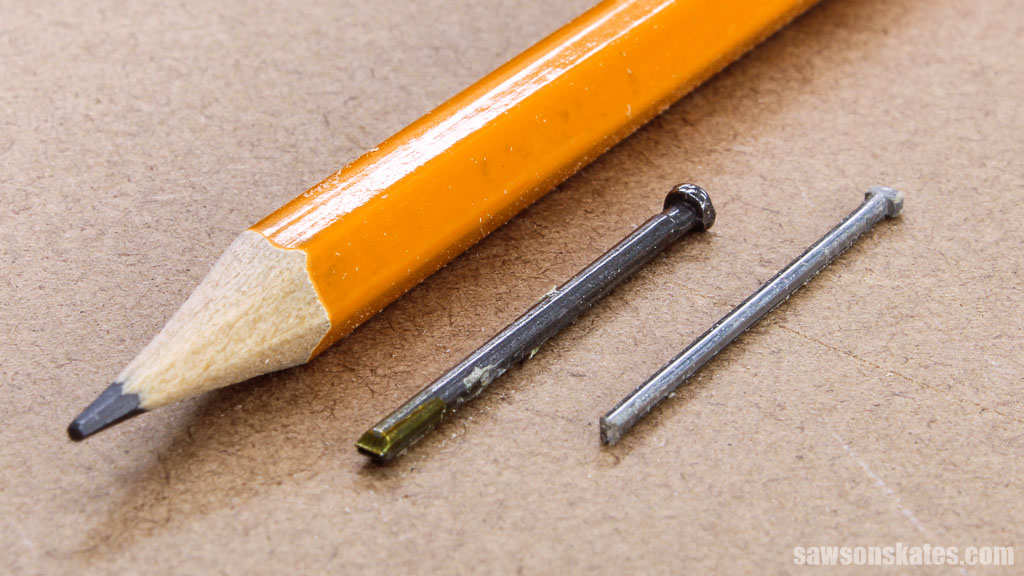
The larger diameter of finishing nails means they have more holding strength than brads. However, a finish nail is more likely to split thin or delicate wood trim, whereas a brad nail’s small size helps to prevent splitting.
In terms of best uses, brad nails are better suited for tasks like light decorative trim and molding, paneling, picture frames, and crafts such as birdhouses. Finish nails are better suited for larger trim, such as baseboards or crown molding.
Additionally, the smaller head of brad nails means it may not require wood filler, whereas a finish nail will leave a larger hole that will need to be filled.
When deciding which type of nail to use for your project, consider the size and weight of the material and whether you want to fill in any holes afterward. Choose brad nails for smaller, lighter projects and finish nails for larger projects.
Is a brad nailer a finish nailer?
A brad nailer and finish nailer are typically used to put the finishing touches on projects, not build them. They are two different tools but serve a similar purpose, so in that respect, they are both types of finish nailers.
A brad nailer is smaller and lighter than a finish nailer. It’s also easier to maneuver in tight spaces. Brad nailers shoot 18-gauge nails, which are thinner and have a smaller diameter than finish nails.
Finish nailers are best for heavier duty projects, such as baseboards, door and window frames, trim work, and cabinetry. Finish nailers shoot 15- or 16-gauge nails with a larger diameter than brad nails.
Which is better a brad nailer or a finish nailer?
Finish nails have greater gripping power than brads, making them an excellent choice for long-lasting projects that require strength and durability. Brads are small, wire-like nails with less holding power than finish nails, so they’re better suited for delicate woodworking projects requiring less strength.
What do you use a brad nailer for?
Woodworkers, do-it-yourselfers, and carpenters use 18-gauge brad nailers to install lightweight trim, ornamental molding, quarter round, shoe molding, door stop molding, and other small trim pieces.
Can I use a brad nailer for baseboards?
Brad nails can be used to attach baseboards. However, a finish nailer might be a better option. Brad nails are small and narrow, making a good choice for installing ornamental molding or lightweight trim. Finish nails have a larger diameter and more gripping power than brad nails, making them the better option for installing heavier and wider pieces of baseboard.
Can you use a brad nailer on a 2×4?
Brad nails are small and narrow, and they lack the holding power to join 2x4s. A framing nailer uses larger diameter nails with more gripping strength than brad nails, making them the better option for joining 2x4s.
What is a finish nail used for?
Finish nails have a larger diameter than brad nails, and they’re better for jobs that need more strength and holding power. Finish nail are excellent for attaching baseboards, window and door trim, chair rails, crown molding, etc.
Can Brad Nails be Used in a Finish Nailer?
No. Using the incorrect nails will cause the nailer to jam.
Can You Use 16 Gauge Nails in an 18 Gauge Nailer?
No. Again, using the incorrect nails will cause the nailer to jam.
Final Thoughts
Brad nailers and finish nailers look similar and do similar things, but a few significant differences set them apart. It’s important to know the differences, so you choose the right one for your project.
Thank you for stopping by. If you enjoyed this tutorial, would you please take a moment and pin it to Pinterest? I’d really appreciate it!

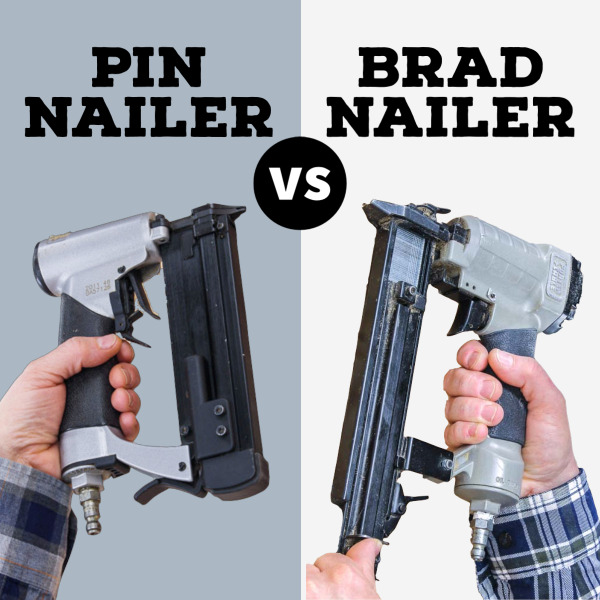
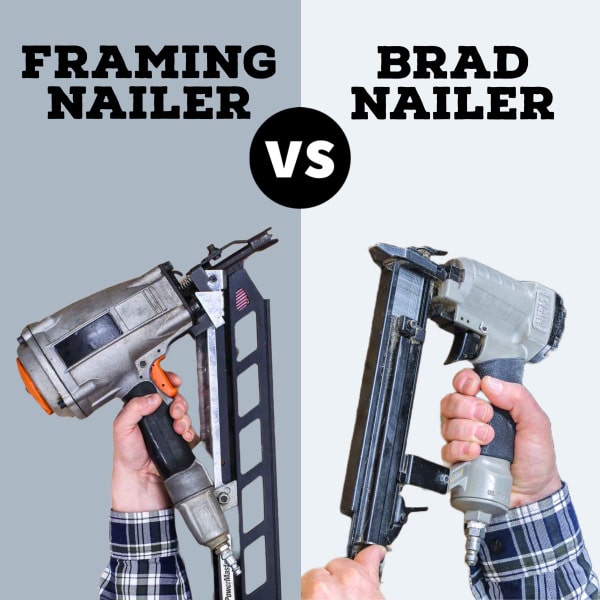
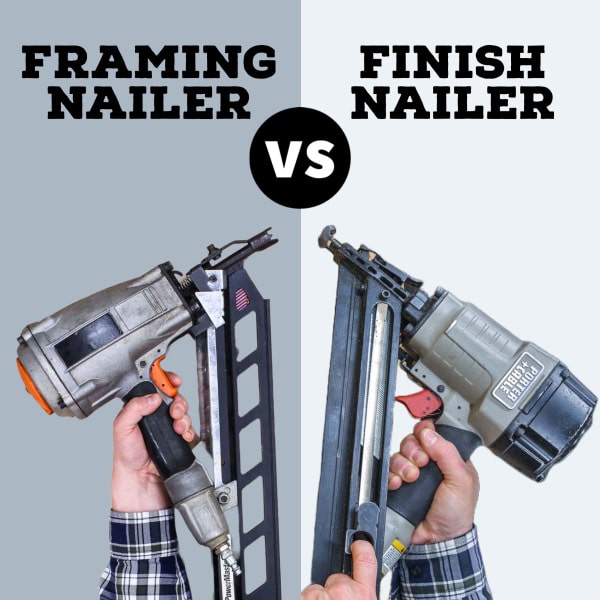
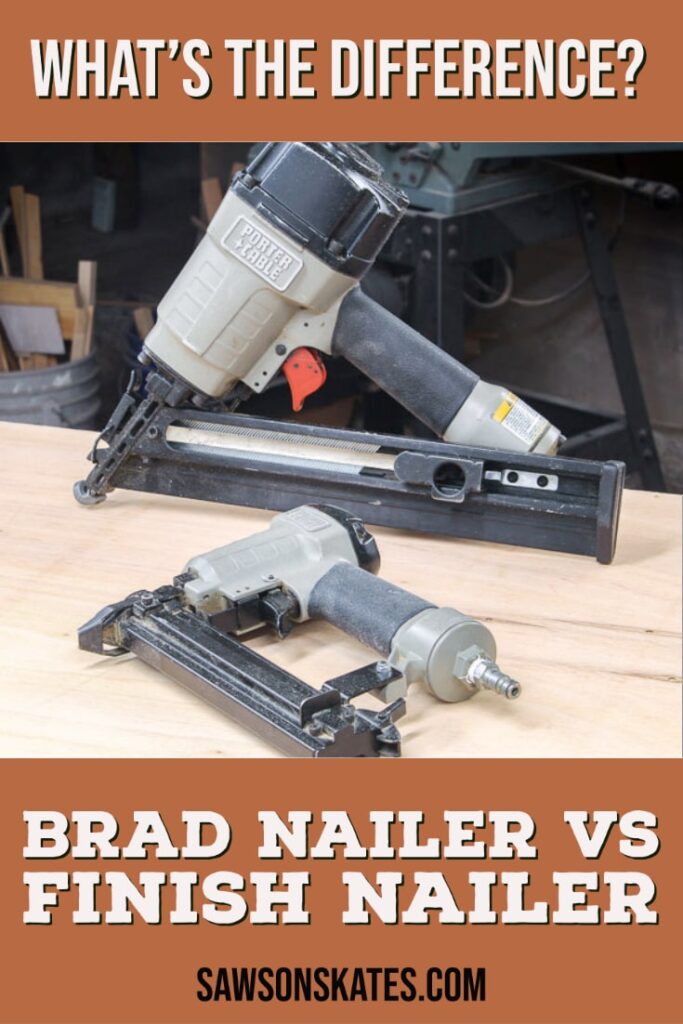
Excellent tutorial. I often wondered what the difference was and which was good for what. Never knew any of what you mention as I just go buy what the salesman says I need, yeah I know silly of me but as a beginner in this woodworking thing what do I know. Most newsletters I read and just delete but his one is staying in my woodworking email box. Thanks so much for writing this review..
You’re welcome, Paul. I’m glad this tutorial was helpful, and thank you for the compliments.